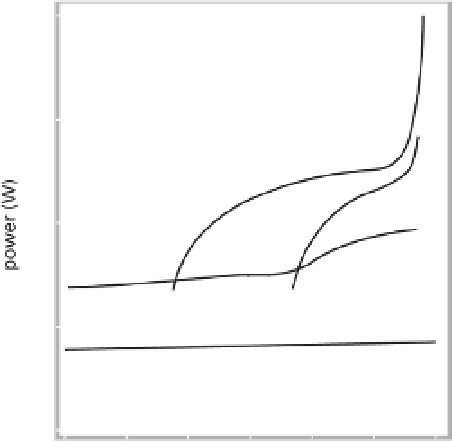Environmental Engineering Reference
In-Depth Information
war captives used as unskilled labor. The dismal labor
productivity and static techniques of ancient Greece
were undoubtedly rooted in this reality. Small-scale man-
ufacturing, construction, and land transport (people car-
rying back-loads, pushing wheelbarrows, or pulling carts,
animals pulling wagons) were dominated by inputs of
50-100 W, the sustainable work rate of adults; concen-
trated animate labor (moving heavy objects, rowing large
ships) could deliver briefly 10-30 kW. Considerable in-
genuity went into the design of mechanical devices
(lever, inclined plane, pulley, treadwheel), but maximum
sustained useful power inputs were raised substantially
only with the widespread diffusion of waterwheels and
windmills (fig. 13.4).
The spreading use of water and wind power, rather
than any extraordinary advances in animate power, set
medieval societies above their ancient ancestors. The ki-
netic energies of water and wind harnessed by increas-
ingly more efficient machines provided unprecedented
concentrations of power for scores of incipient industrial
applications. The unit ratings of waterwheels remained
limited for centuries (even in the eighteenth century
the typical size did not exceed 4 kW), but multiple in-
stallations delivered 10-20 kW at a single site during
Roman times and close to 100 kW after the year
1700. Major technical improvements during the nine-
teenth century led to units of up to 400 kW. Grain mill-
ing was the most frequent early use, followed later by
many processing and manufacturing tasks. Medieval post
windmills delivered just a few kilowatts of useful power,
but tower and smock mills of the eighteenth and nine-
teenth centuries supplied 6-14 kW, much less than
contemporary hydraulic installations. In many windy
regions windmills played a crucial
role in incipient
industrialization.
Fossil fuels were known (and sporadically used) by
some preindustrial civilizations, but their thermal energy
needs came principally from combustion of phytomass.
Absolutely dry wood has 17-21 MJ/kg (softwoods have
the highest energy density), and crop residues (mainly
cereal straws) 17-18 MJ/kg. When burned (air-dried),
these fuels usually have about 15 MJ/kg, but most of
their heat content was wasted in open fires and simple
fireplaces, which deliver no more than 5%-10% of useful
energy. In warm climates the annual consumption of
phytomass fuels was less than 10 GJ per capita, in the
mid-latitudes (and in manufacturing uses) up to 50 GJ
per capita, and in the most advanced wooden-age soci-
ety, the United States in the mid-nineteenth century,
close to 100 GJ per capita. Since the late Middle Ages
production of high-energy-density charcoal (@30 MJ/
13.4 Maximum unit power of preindustrial prime movers.
























